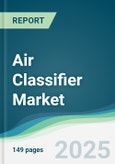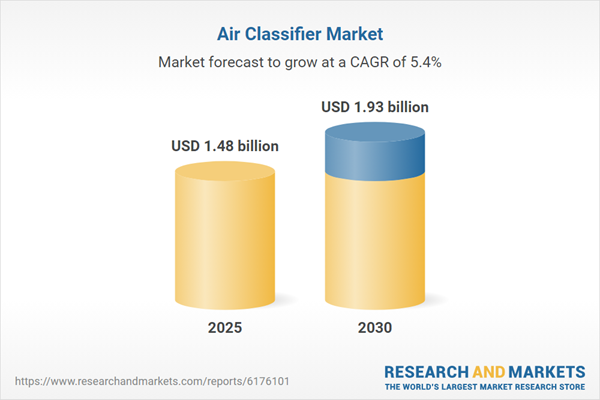Air classifiers represent sophisticated industrial separation equipment designed to segregate mixed materials based on the combined principles of size, form, and volume differentiation. These machines utilize aerodynamic forces to achieve precise material separation, making them indispensable across multiple industrial sectors where efficient processing of heterogeneous material streams is critical.
The technology finds extensive application across diverse industrial verticals, including cement manufacturing, pollution control systems, food processing, pigment production, pharmaceutical manufacturing, cosmetic production, and chemical processing operations. The fundamental capability to rapidly and efficiently separate large volumes of mixed materials with varying physical properties positions air classifiers as essential equipment for industries requiring high-throughput processing with consistent quality outcomes.
Market Segmentation and Growth Drivers
The air classifier market demonstrates robust growth potential driven primarily by expansion in the energy, construction, and mining sectors globally. These industries collectively represent the largest consumption base for air classification technology, creating sustained demand for advanced separation equipment capable of handling diverse material processing requirements.The mining sector emergence as a primary market catalyst reflects the increasing emphasis on operational efficiency and effectiveness in processing operations involving sand, coal, ores, and aggregates. Air classifiers' design specifically targets solid material separation from complex mixtures, resulting in widespread adoption across building, mining, and energy sectors worldwide. This acceptance is driven by the technology's ability to improve processing efficiency while reducing operational costs associated with manual separation methods.
The cement industry represents another significant application area where air classifiers contribute to quality control and processing efficiency. The ability to achieve precise particle size distribution and remove unwanted materials from cement production streams directly impacts final product quality and manufacturing efficiency.
Technological Innovation and Product Development
The air classifier market benefits from continuous technological advancement and product innovation designed to enhance operational capabilities and expand application possibilities. Modern air classification systems incorporate sophisticated control mechanisms that enable precise particle cut point selection, allowing operators to achieve specific separation criteria based on application requirements.Advanced air classifier designs feature modular construction with accessible maintenance points, facilitating rapid product changeover, operational monitoring, cleaning procedures, and routine maintenance activities. These design improvements directly address industrial requirements for flexible production capabilities and minimal downtime in high-volume manufacturing environments.
Temperature control capabilities and particle size dispersion management represent critical technological features that expand air classifier applicability across industries producing fine powders where thermal sensitivity and particle uniformity are essential quality parameters. These capabilities enable air classification technology to serve specialized applications in pharmaceutical, cosmetic, and food processing sectors where precise material characteristics are mandatory.
Strategic Industry Developments and Future Outlook
The air classifier market demonstrates positive momentum through strategic partnerships and technological collaborations that enhance processing capabilities and expand application opportunities. Industry partnerships focus on developing integrated solutions that combine air classification with complementary processing technologies, creating comprehensive material processing systems that deliver enhanced value to end users.Investment activity in air classification technology development indicates strong industry confidence in market growth potential. Companies are directing resources toward developing scalable air classification technologies that address specific industry challenges, particularly in raw material beneficiation and processing optimization applications.
The geographic concentration of mining and energy sector growth in developing regions creates additional market expansion opportunities for air classifier manufacturers. As these regions continue industrial development and infrastructure expansion, demand for efficient material processing equipment, including air classifiers, is expected to increase proportionally.
Industry experts should anticipate continued market growth driven by industrial expansion in key application sectors, ongoing technological innovation that enhances equipment capabilities, and increasing emphasis on operational efficiency across material processing industries. The convergence of these factors positions the air classifier market for sustained expansion throughout the forecast period.
Key Benefits of this Report:
- Insightful Analysis: Gain detailed market insights covering major as well as emerging geographical regions, focusing on customer segments, government policies and socio-economic factors, consumer preferences, industry verticals, and other sub-segments.
- Competitive Landscape: Understand the strategic maneuvers employed by key players globally to understand possible market penetration with the correct strategy.
- Market Drivers & Future Trends: Explore the dynamic factors and pivotal market trends and how they will shape future market developments.
- Actionable Recommendations: Utilize the insights to exercise strategic decisions to uncover new business streams and revenues in a dynamic environment.
- Caters to a Wide Audience: Beneficial and cost-effective for startups, research institutions, consultants, SMEs, and large enterprises.
What do businesses use these reports for?
Industry and Market Insights, Opportunity Assessment, Product Demand Forecasting, Market Entry Strategy, Geographical Expansion, Capital Investment Decisions, Regulatory Framework & Implications, New Product Development, Competitive IntelligenceReport Coverage:
- Historical data from 2022 to 2024 & forecast data from 2025 to 2030
- Growth Opportunities, Challenges, Supply Chain Outlook, Regulatory Framework, and Trend Analysis
- Competitive Positioning, Strategies, and Market Share Analysis
- Revenue Growth and Forecast Assessment of segments and regions including countries
- Company Profiling (Strategies, Products, Financial Information, and Key Developments among others.
The air classifier market has been analyzed through the following segments:
By Type
- Gravitational
- Centrifugal
- Others
By Application
- Mineral Processing
- Sand Manufacturing
- Material Processing
- Others
By End-User
- Building & Construction
- Mining
- Food & Beverage
- Pharmaceuticals
- Others
By Geography
- North America
- USA
- Canada
- Mexico
- South America
- Brazil
- Argentina
- Others
- Europe
- Germany
- France
- United Kingdom
- Italy
- Spain
- Others
- Middle East and Africa
- Saudi Arabia
- UAE
- Israel
- Others
- Asia Pacific
- China
- India
- Japan
- South Korea
- Indonesia
- Thailand
- Taiwan
- Australia
- Others
Table of Contents
Companies Mentioned
- Metso
- Van Tongeren America LLC
- Prater Industries
- Hosokawa Micron Group
- Techno Design
- Sturtevant Inc
- Ultra Febtech Pvt. Ltd
- Nisshin Engineering Inc.
- NEUMAN & ESSER GROUP
- NETZSCH Group
Table Information
| Report Attribute | Details |
|---|---|
| No. of Pages | 149 |
| Published | August 2025 |
| Forecast Period | 2025 - 2030 |
| Estimated Market Value ( USD | $ 1.48 billion |
| Forecasted Market Value ( USD | $ 1.93 billion |
| Compound Annual Growth Rate | 5.4% |
| Regions Covered | Global |
| No. of Companies Mentioned | 10 |









